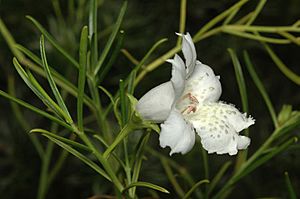Twiggy emu-bush facts for kids
Quick facts for kids Twiggy emu-bush |
|
|---|---|
 |
|
| Scientific classification | |
| Genus: |
Eremophila (plant)
|
| Species: |
polyclada
|
| Synonyms | |
|
|
The Twiggy Emu-bush (scientific name: Eremophila polyclada) is a special plant found only in Australia. People also call it Flowering Lignum, Lignum Fuchsia, or Desert Lignum. It belongs to the figwort family called Scrophulariaceae.
This plant is a thick, spreading bush. It has thin leaves and pretty white or light purple flowers. These flowers often have purple spots. You can find the Twiggy Emu-bush in most parts of mainland Australia, but not in Western Australia.
Contents
What the Twiggy Emu-Bush Looks Like
The Twiggy Emu-bush is a dense, spreading shrub. It usually grows to be about 1–3 m (3–10 ft) tall. It can also spread out wide, up to 1–5 m (3–20 ft) across. Its branches stick out almost straight from each other. They are stiff and sometimes have a sharp point at the end.
The leaves grow one after another along the branches. They are long and narrow, usually about 20–40 mm (0.8–2 in) long. They are only about 1–3 mm (0.04–0.1 in) wide. When the leaves are young, they can feel sticky. This is because they have a natural sticky substance called resin on them.
Flowers and Fruits
The flowers of the Twiggy Emu-bush grow alone or in pairs. They appear where the leaves meet the branches. Each flower sits on a short stalk, about 1–2.5 mm (0.04–0.1 in) long.
Each flower has 5 green, overlapping parts called sepals. These sepals are shaped like eggs and have a clear ridge down the middle. They are usually 4.5–7 mm (0.2–0.3 in) long. The petals of the flower are 20–35 mm (0.8–1 in) long. They join together at their base to form a tube shape.
The petal tube is white or a very pale whitish-lilac color. Inside the tube and on the tips of the petals, you can see faint blackish or green-purple spots. The outside of the tube and petals is smooth, without hairs. However, the middle part of the lowest petal and the inside of the tube are hairy. There are 4 stamens (the parts that make pollen) hidden inside the flower tube.
Twiggy Emu-bush flowers usually appear between October and May. After the flowers, the plant grows fruits. These fruits are oval, cone-shaped, or elliptical with a pointed end. They are about 8.5–13 mm (0.3–0.5 in) long.
How the Twiggy Emu-Bush Got Its Name
The Twiggy Emu-bush was first officially described in 1855. A famous botanist named Ferdinand von Mueller gave it the name Pholidia polyclada. He wrote about it in a journal called Journal of an Expedition into the Interior of Tropical Australia.
Later, in 1860, Mueller changed the name to Eremophila polyclada. The second part of its scientific name, polyclada, comes from two words in ancient Greek. Polys (πολύς) means "many," and klados (κλάδος) means "twig." So, polyclada means "many twigs," which perfectly describes this bush!
Where the Twiggy Emu-Bush Grows
The Twiggy Emu-bush is found in many places across Australia. It grows widely in New South Wales, especially west of Lightning Ridge. You can also find it in southern Queensland.
There are also some areas where it grows along the Murray River in Victoria and South Australia. There is even one record of it growing in the Northern Territory, near a place called Tarlton Downs. This plant likes to grow in sandy or clay soils. You often find it in areas that flood, like floodplains, or other low-lying spots.
Growing Twiggy Emu-Bush in Gardens
The Twiggy Emu-bush is a very popular plant for gardens. It is known for being a beautiful shrub. Some of these plants have been growing in gardens for over 35 years!
It produces lots of white flowers during the summer. This is great because many other shrubs don't flower much then. Its thick, tangled branches make it a good plant for creating a screen or hedge in a garden.
How to Grow It
It's quite easy to grow new Twiggy Emu-bushes from cuttings. Cuttings are small pieces of the plant that can grow roots. They usually start to grow roots within a few weeks if the weather is warm. Sometimes, if its arching branches touch the ground, they will even grow roots on their own!
This shrub is very good at handling dry conditions. It doesn't need much water, maybe only once or twice during a long dry spell. Giving it a good deep watering early in summer can even make it flower more. The Twiggy Emu-bush can also handle frost. You can prune it (trim its branches) to shape it, and the best time to do this is in early autumn.
There is also a special plant called Eremophila 'summertime blue'. This plant is a mix (a hybrid) of the Twiggy Emu-bush and another plant called E. divaricata. It is very popular in gardens in America.

